Organizational Behavior: Team Development Theories & Cooperation
VerifiedAdded on 2023/06/15
|8
|1833
|149
Case Study
AI Summary
This case study delves into organizational behavior, focusing on team development theories and the factors influencing cooperation within teams. It examines the characteristics of effective and ineffective teams, highlighting the importance of communication, trust, and defined objectives. The study explores Belbin's team roles and the path-goal theory of leadership, emphasizing their relevance in improving business performance and productivity. Google is used as an example, discussing how managers can adopt participatory leadership styles to enhance employee motivation and achieve organizational goals. The analysis provides insights into creating a positive work environment that fosters collaboration and continuous learning.
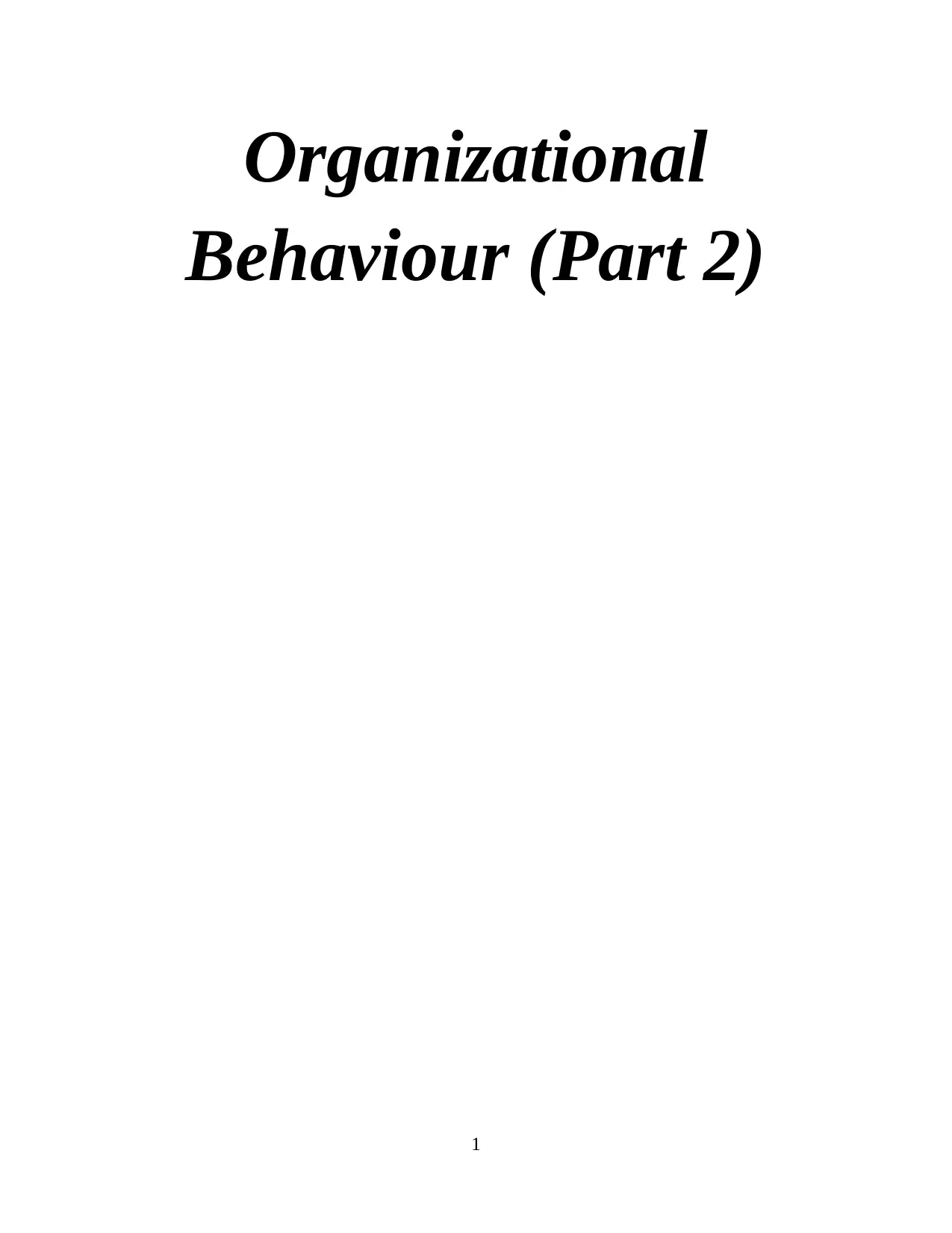
Organizational
Behaviour (Part 2)
1
Behaviour (Part 2)
1
Paraphrase This Document
Need a fresh take? Get an instant paraphrase of this document with our AI Paraphraser
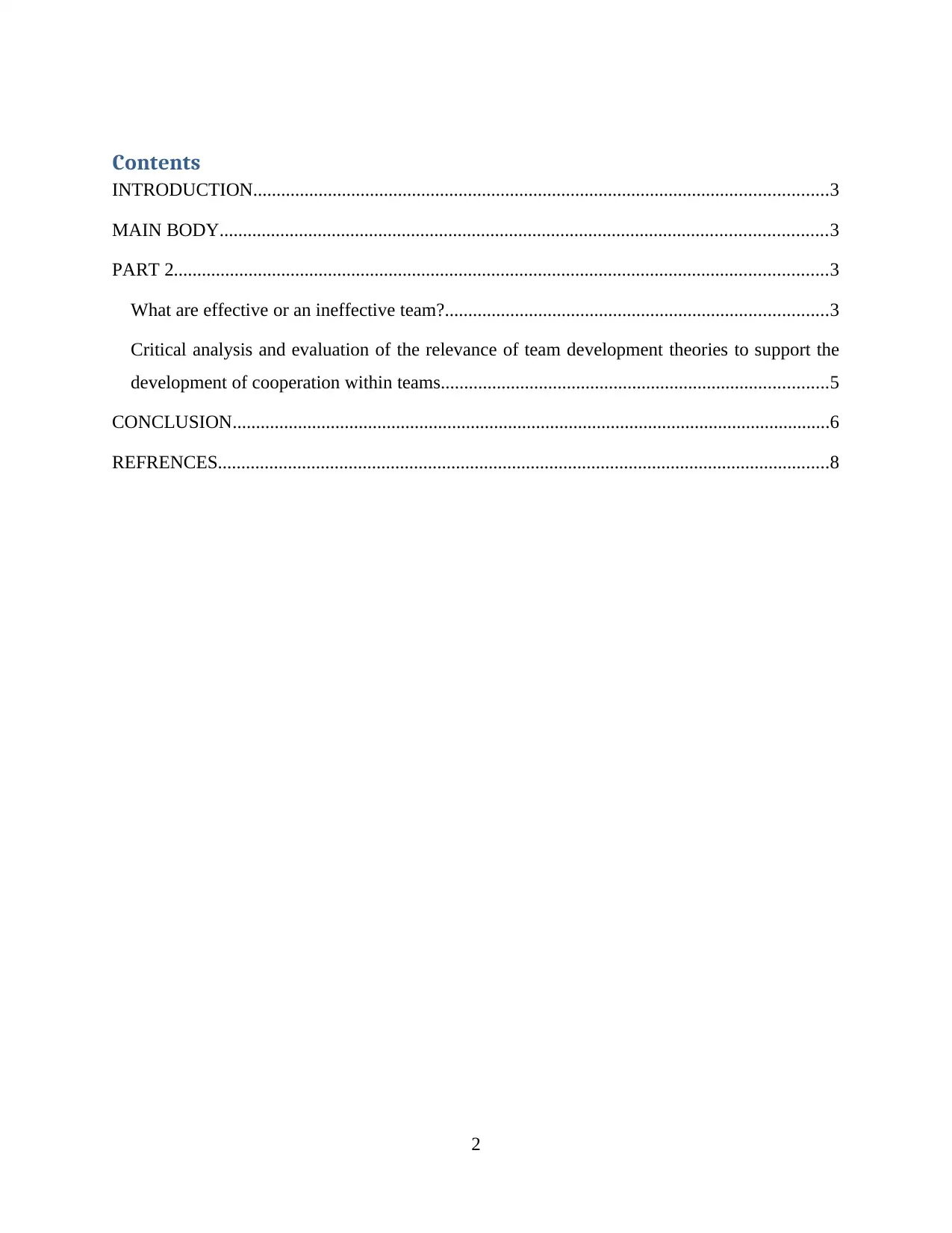
Contents
INTRODUCTION...........................................................................................................................3
MAIN BODY..................................................................................................................................3
PART 2............................................................................................................................................3
What are effective or an ineffective team?..................................................................................3
Critical analysis and evaluation of the relevance of team development theories to support the
development of cooperation within teams...................................................................................5
CONCLUSION................................................................................................................................6
REFRENCES...................................................................................................................................8
2
INTRODUCTION...........................................................................................................................3
MAIN BODY..................................................................................................................................3
PART 2............................................................................................................................................3
What are effective or an ineffective team?..................................................................................3
Critical analysis and evaluation of the relevance of team development theories to support the
development of cooperation within teams...................................................................................5
CONCLUSION................................................................................................................................6
REFRENCES...................................................................................................................................8
2
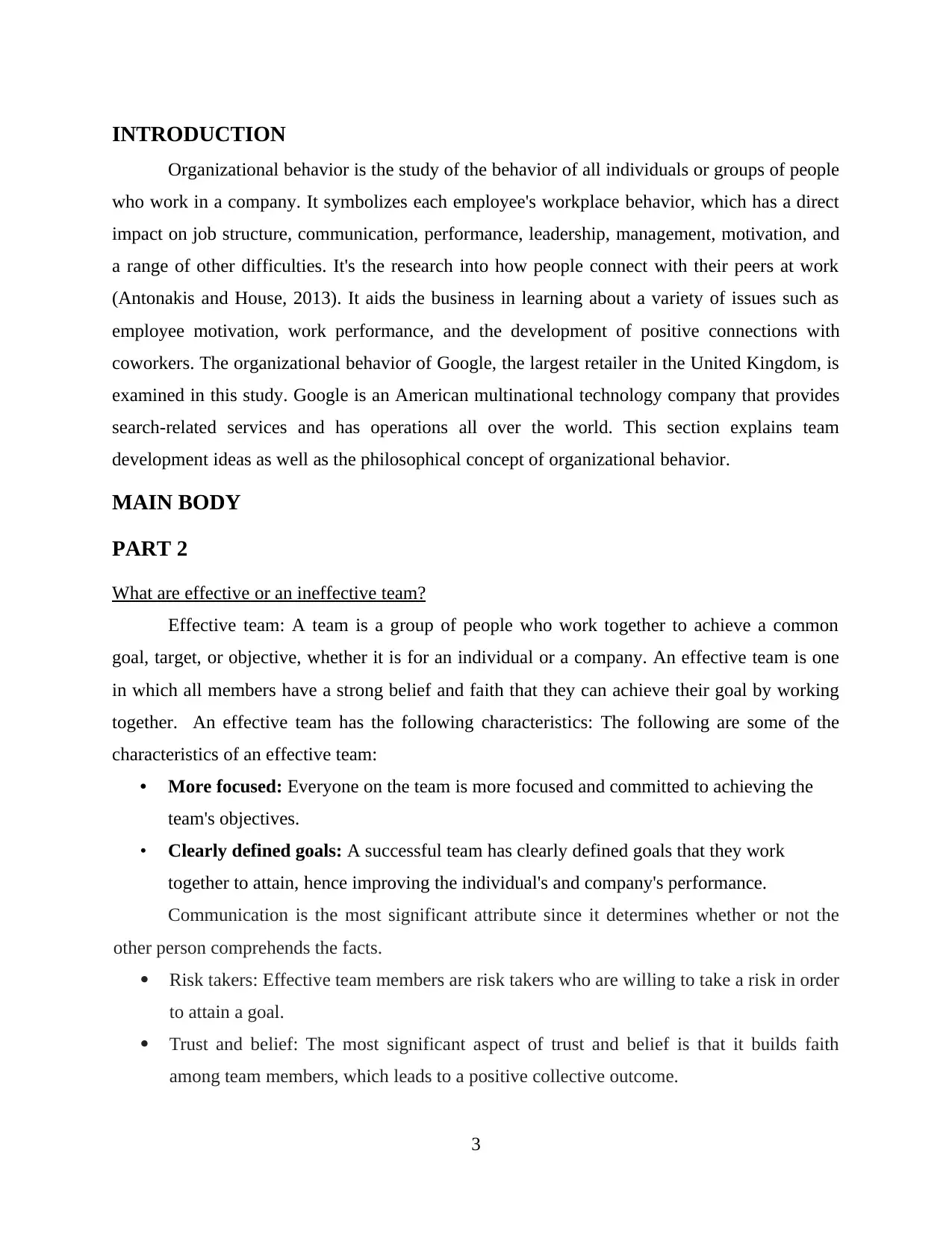
INTRODUCTION
Organizational behavior is the study of the behavior of all individuals or groups of people
who work in a company. It symbolizes each employee's workplace behavior, which has a direct
impact on job structure, communication, performance, leadership, management, motivation, and
a range of other difficulties. It's the research into how people connect with their peers at work
(Antonakis and House, 2013). It aids the business in learning about a variety of issues such as
employee motivation, work performance, and the development of positive connections with
coworkers. The organizational behavior of Google, the largest retailer in the United Kingdom, is
examined in this study. Google is an American multinational technology company that provides
search-related services and has operations all over the world. This section explains team
development ideas as well as the philosophical concept of organizational behavior.
MAIN BODY
PART 2
What are effective or an ineffective team?
Effective team: A team is a group of people who work together to achieve a common
goal, target, or objective, whether it is for an individual or a company. An effective team is one
in which all members have a strong belief and faith that they can achieve their goal by working
together. An effective team has the following characteristics: The following are some of the
characteristics of an effective team:
• More focused: Everyone on the team is more focused and committed to achieving the
team's objectives.
• Clearly defined goals: A successful team has clearly defined goals that they work
together to attain, hence improving the individual's and company's performance.
Communication is the most significant attribute since it determines whether or not the
other person comprehends the facts.
Risk takers: Effective team members are risk takers who are willing to take a risk in order
to attain a goal.
Trust and belief: The most significant aspect of trust and belief is that it builds faith
among team members, which leads to a positive collective outcome.
3
Organizational behavior is the study of the behavior of all individuals or groups of people
who work in a company. It symbolizes each employee's workplace behavior, which has a direct
impact on job structure, communication, performance, leadership, management, motivation, and
a range of other difficulties. It's the research into how people connect with their peers at work
(Antonakis and House, 2013). It aids the business in learning about a variety of issues such as
employee motivation, work performance, and the development of positive connections with
coworkers. The organizational behavior of Google, the largest retailer in the United Kingdom, is
examined in this study. Google is an American multinational technology company that provides
search-related services and has operations all over the world. This section explains team
development ideas as well as the philosophical concept of organizational behavior.
MAIN BODY
PART 2
What are effective or an ineffective team?
Effective team: A team is a group of people who work together to achieve a common
goal, target, or objective, whether it is for an individual or a company. An effective team is one
in which all members have a strong belief and faith that they can achieve their goal by working
together. An effective team has the following characteristics: The following are some of the
characteristics of an effective team:
• More focused: Everyone on the team is more focused and committed to achieving the
team's objectives.
• Clearly defined goals: A successful team has clearly defined goals that they work
together to attain, hence improving the individual's and company's performance.
Communication is the most significant attribute since it determines whether or not the
other person comprehends the facts.
Risk takers: Effective team members are risk takers who are willing to take a risk in order
to attain a goal.
Trust and belief: The most significant aspect of trust and belief is that it builds faith
among team members, which leads to a positive collective outcome.
3
⊘ This is a preview!⊘
Do you want full access?
Subscribe today to unlock all pages.

Trusted by 1+ million students worldwide

Mutual decision-making: In a team, each member has their own way of thinking, and an
effective team will reach a decision based on mutual understanding. Factor of effective
team: There are several factors of effective team these are as follows:
Defined roles and responsibilities: Effective team members are aware of their
responsibilities, which allows them to work more efficiently (Wong, Ormiston and
Tetlock, 2011).
Leadership: The ability to lead others in the form of providing direction, assisting those
in need, and setting goals that lead to successful outcomes.
Defined objectives: Each team member has a clear objective that allows them to work in
a consistent manner, resulting in improved performance.
Learning and development: An effective team promotes continual learning and
development by attaining various goals under various circumstances.
Ineffective team: An ineffective team is one that does not have established goals, has a
lack of understanding among team members. There are various characteristics of an ineffective
team, including:
Lack of trust and belief: When team members lack trust and belief in one another, it leads
to misunderstanding.
Lack of communication: Communication is the only way for information to get around,
and if it isn't handled properly, it can lead to more complications.
Lack of commitment: When a team member is unwilling to improve or achieve the goals,
it has negative consequences.
Undefined objectives: If the objectives and goals are not defined, the environment
becomes unbalanced.
There are various factors that contribute to an unproductive team, including the
following:
Ineffective time management: When time is not managed well in a team, it causes
disruption and leads to an ineffective team.
Ineffective team interaction: If team members do not interact well, the team will be
ineffective.
Difference between effective and ineffective team:
4
effective team will reach a decision based on mutual understanding. Factor of effective
team: There are several factors of effective team these are as follows:
Defined roles and responsibilities: Effective team members are aware of their
responsibilities, which allows them to work more efficiently (Wong, Ormiston and
Tetlock, 2011).
Leadership: The ability to lead others in the form of providing direction, assisting those
in need, and setting goals that lead to successful outcomes.
Defined objectives: Each team member has a clear objective that allows them to work in
a consistent manner, resulting in improved performance.
Learning and development: An effective team promotes continual learning and
development by attaining various goals under various circumstances.
Ineffective team: An ineffective team is one that does not have established goals, has a
lack of understanding among team members. There are various characteristics of an ineffective
team, including:
Lack of trust and belief: When team members lack trust and belief in one another, it leads
to misunderstanding.
Lack of communication: Communication is the only way for information to get around,
and if it isn't handled properly, it can lead to more complications.
Lack of commitment: When a team member is unwilling to improve or achieve the goals,
it has negative consequences.
Undefined objectives: If the objectives and goals are not defined, the environment
becomes unbalanced.
There are various factors that contribute to an unproductive team, including the
following:
Ineffective time management: When time is not managed well in a team, it causes
disruption and leads to an ineffective team.
Ineffective team interaction: If team members do not interact well, the team will be
ineffective.
Difference between effective and ineffective team:
4
Paraphrase This Document
Need a fresh take? Get an instant paraphrase of this document with our AI Paraphraser

Effective team Ineffective team
Objectives Cleared and focused towards
objectives
Uncleared objectives
Management Well defined and proper channel
Roles and responsibility Cleared towards roles and
responsibility and creates better
workforce.
No one understand the roles and
responsibility and that create
uneven environment
Communication better and effective communication No communication
Belbin theory: The manager of Google must evaluate the individual function in a team in order
to build the strengths and analyse the weaknesses that affect the team's performance. Belbin team
roles are the many team responsibilities that are performed by individuals or workers of Google
and that must be considered by the management in order to improve the team's performance.
There are a few Belbin team roles to be aware of:
Team player: The team worker is the one who effectively deals with or handles all
situations. team worker is someone who manages all conditions and makes decisions in the best
interests of the team.(Coccia, 2015).
Coordinator: The coordinator is the person who is self-assured, calm and composed,
more creative, and so on. Google's major purpose is to keep control of the teams and
ensure that they perform well.
Specialist: A specialist is someone who assists the team in overcoming obstacles and
thereby improving the team's performance.
Implementer: The most practical individual is the implementer, who converts the idea
into a framework and creates a good environment (Gkorezis and Petridou, 2017).
Critical analysis and evaluation of the relevance of team development theories to support the
development of cooperation within teams.
Reflection on the concepts and philosophies of organizational behaviour that may
have informed and influenced behaviour in the team activity, and a critical analysis and
evolution of their relevance to improving business performance and productivity.
5
Objectives Cleared and focused towards
objectives
Uncleared objectives
Management Well defined and proper channel
Roles and responsibility Cleared towards roles and
responsibility and creates better
workforce.
No one understand the roles and
responsibility and that create
uneven environment
Communication better and effective communication No communication
Belbin theory: The manager of Google must evaluate the individual function in a team in order
to build the strengths and analyse the weaknesses that affect the team's performance. Belbin team
roles are the many team responsibilities that are performed by individuals or workers of Google
and that must be considered by the management in order to improve the team's performance.
There are a few Belbin team roles to be aware of:
Team player: The team worker is the one who effectively deals with or handles all
situations. team worker is someone who manages all conditions and makes decisions in the best
interests of the team.(Coccia, 2015).
Coordinator: The coordinator is the person who is self-assured, calm and composed,
more creative, and so on. Google's major purpose is to keep control of the teams and
ensure that they perform well.
Specialist: A specialist is someone who assists the team in overcoming obstacles and
thereby improving the team's performance.
Implementer: The most practical individual is the implementer, who converts the idea
into a framework and creates a good environment (Gkorezis and Petridou, 2017).
Critical analysis and evaluation of the relevance of team development theories to support the
development of cooperation within teams.
Reflection on the concepts and philosophies of organizational behaviour that may
have informed and influenced behaviour in the team activity, and a critical analysis and
evolution of their relevance to improving business performance and productivity.
5

The path goal theory of leadership instructs an organization's management to adopt
appropriate leadership styles and behaviour based on the working environment and employee
demands. Google can employ a participatory leadership style, in which managers are directed to
solicit opinions and suggestions from their employees prior to making business choices.(Laforet,
2016).
Classification of path goal theory-
Employee characteristics- In the case of Google, the manager must identify such
variables and address them within a set time frame in order to improve employee
productivity.
Task and environmental characteristics- In the case of Google, the manager should
conduct a workplace survey to determine their task requirements and meet them within a
defined time frame.
Leadership types: Leadership styles assist the leader or manager in leading and monitoring the
organization's workforce. People can be led and guided in a variety of ways. They're discussed
farther down.
Participative style- In this style, employees are given the opportunity to offer
suggestions and opinions during the decision-making. Google's manager's use of this
technique has resulted in higher staff retention and contributions to the attainment of the
company's goals and objectives.
Directive style- In this approach, managers tell their staff that they must obey their
orders without question. Employees are obligated to follow predetermined decisions,
which have a negative impact on their performance.
Employees are motivated when the organization's goals and objectives are clearly defined
since it helps them comprehend their roles and responsibilities. As a result, they make the
greatest contribution to the attainment of organisational goals and objectives by enlisting
management's help in removing any hurdles.
CONCLUSION
The study of the behavior of all individuals or groups of people who work in a firm is
known as organizational behavior. It represents each employee's conduct in the workplace, which
has a direct impact on job structure, communication, performance, leadership, management,
motivation, and a variety of other issues. It's a study of how people interact with their coworkers
6
appropriate leadership styles and behaviour based on the working environment and employee
demands. Google can employ a participatory leadership style, in which managers are directed to
solicit opinions and suggestions from their employees prior to making business choices.(Laforet,
2016).
Classification of path goal theory-
Employee characteristics- In the case of Google, the manager must identify such
variables and address them within a set time frame in order to improve employee
productivity.
Task and environmental characteristics- In the case of Google, the manager should
conduct a workplace survey to determine their task requirements and meet them within a
defined time frame.
Leadership types: Leadership styles assist the leader or manager in leading and monitoring the
organization's workforce. People can be led and guided in a variety of ways. They're discussed
farther down.
Participative style- In this style, employees are given the opportunity to offer
suggestions and opinions during the decision-making. Google's manager's use of this
technique has resulted in higher staff retention and contributions to the attainment of the
company's goals and objectives.
Directive style- In this approach, managers tell their staff that they must obey their
orders without question. Employees are obligated to follow predetermined decisions,
which have a negative impact on their performance.
Employees are motivated when the organization's goals and objectives are clearly defined
since it helps them comprehend their roles and responsibilities. As a result, they make the
greatest contribution to the attainment of organisational goals and objectives by enlisting
management's help in removing any hurdles.
CONCLUSION
The study of the behavior of all individuals or groups of people who work in a firm is
known as organizational behavior. It represents each employee's conduct in the workplace, which
has a direct impact on job structure, communication, performance, leadership, management,
motivation, and a variety of other issues. It's a study of how people interact with their coworkers
6
⊘ This is a preview!⊘
Do you want full access?
Subscribe today to unlock all pages.

Trusted by 1+ million students worldwide
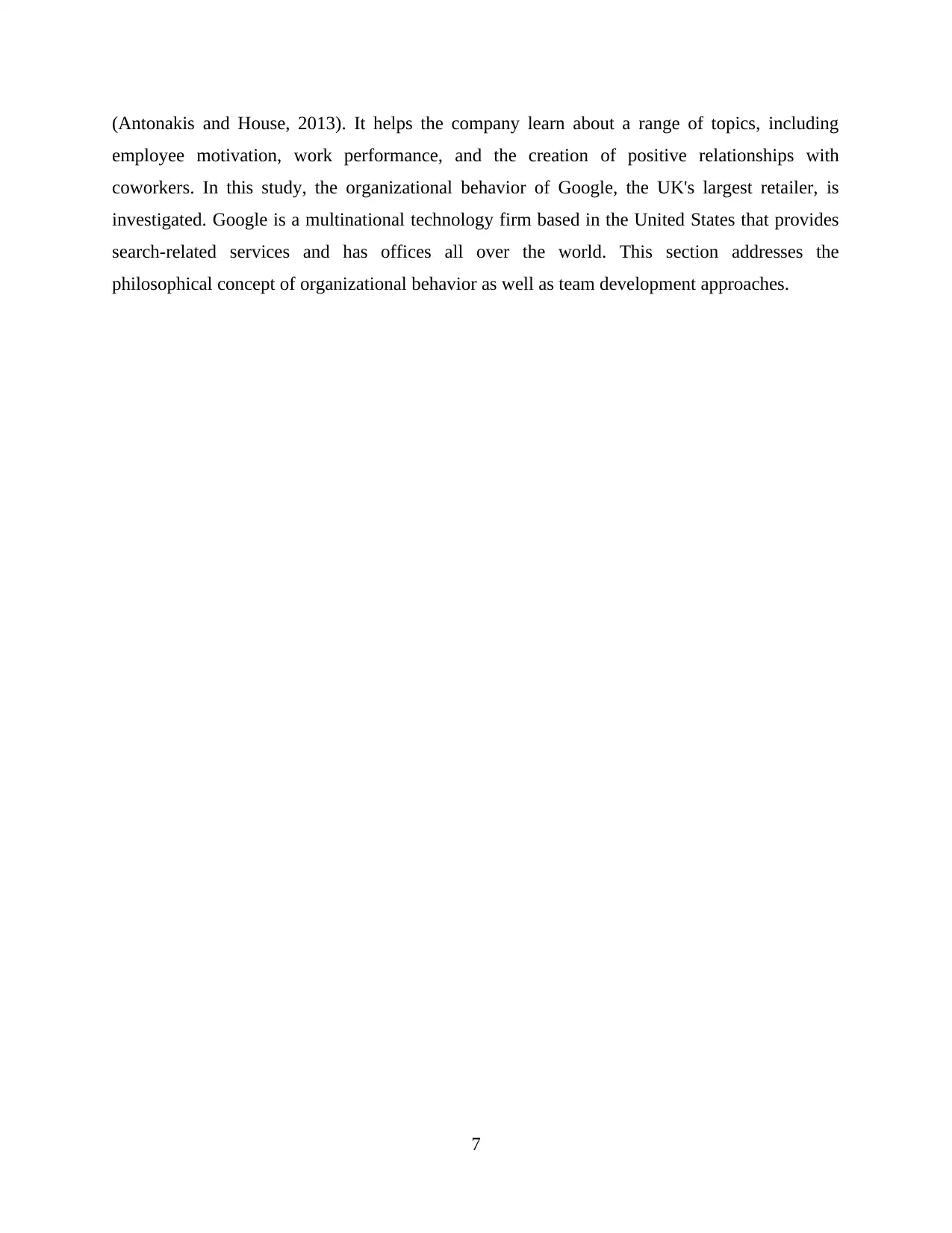
(Antonakis and House, 2013). It helps the company learn about a range of topics, including
employee motivation, work performance, and the creation of positive relationships with
coworkers. In this study, the organizational behavior of Google, the UK's largest retailer, is
investigated. Google is a multinational technology firm based in the United States that provides
search-related services and has offices all over the world. This section addresses the
philosophical concept of organizational behavior as well as team development approaches.
7
employee motivation, work performance, and the creation of positive relationships with
coworkers. In this study, the organizational behavior of Google, the UK's largest retailer, is
investigated. Google is a multinational technology firm based in the United States that provides
search-related services and has offices all over the world. This section addresses the
philosophical concept of organizational behavior as well as team development approaches.
7
Paraphrase This Document
Need a fresh take? Get an instant paraphrase of this document with our AI Paraphraser
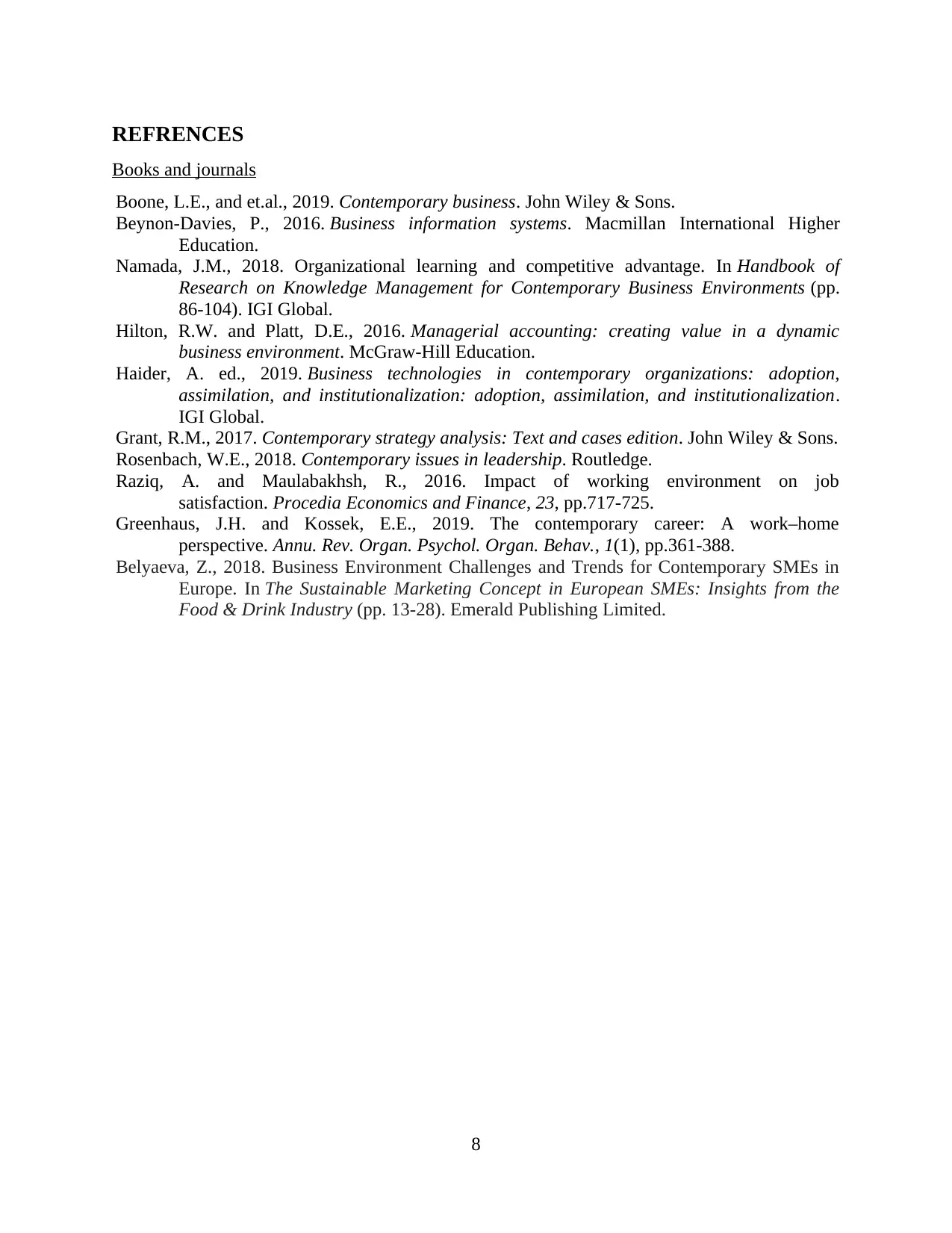
REFRENCES
Books and journals
Boone, L.E., and et.al., 2019. Contemporary business. John Wiley & Sons.
Beynon-Davies, P., 2016. Business information systems. Macmillan International Higher
Education.
Namada, J.M., 2018. Organizational learning and competitive advantage. In Handbook of
Research on Knowledge Management for Contemporary Business Environments (pp.
86-104). IGI Global.
Hilton, R.W. and Platt, D.E., 2016. Managerial accounting: creating value in a dynamic
business environment. McGraw-Hill Education.
Haider, A. ed., 2019. Business technologies in contemporary organizations: adoption,
assimilation, and institutionalization: adoption, assimilation, and institutionalization.
IGI Global.
Grant, R.M., 2017. Contemporary strategy analysis: Text and cases edition. John Wiley & Sons.
Rosenbach, W.E., 2018. Contemporary issues in leadership. Routledge.
Raziq, A. and Maulabakhsh, R., 2016. Impact of working environment on job
satisfaction. Procedia Economics and Finance, 23, pp.717-725.
Greenhaus, J.H. and Kossek, E.E., 2019. The contemporary career: A work–home
perspective. Annu. Rev. Organ. Psychol. Organ. Behav., 1(1), pp.361-388.
Belyaeva, Z., 2018. Business Environment Challenges and Trends for Contemporary SMEs in
Europe. In The Sustainable Marketing Concept in European SMEs: Insights from the
Food & Drink Industry (pp. 13-28). Emerald Publishing Limited.
8
Books and journals
Boone, L.E., and et.al., 2019. Contemporary business. John Wiley & Sons.
Beynon-Davies, P., 2016. Business information systems. Macmillan International Higher
Education.
Namada, J.M., 2018. Organizational learning and competitive advantage. In Handbook of
Research on Knowledge Management for Contemporary Business Environments (pp.
86-104). IGI Global.
Hilton, R.W. and Platt, D.E., 2016. Managerial accounting: creating value in a dynamic
business environment. McGraw-Hill Education.
Haider, A. ed., 2019. Business technologies in contemporary organizations: adoption,
assimilation, and institutionalization: adoption, assimilation, and institutionalization.
IGI Global.
Grant, R.M., 2017. Contemporary strategy analysis: Text and cases edition. John Wiley & Sons.
Rosenbach, W.E., 2018. Contemporary issues in leadership. Routledge.
Raziq, A. and Maulabakhsh, R., 2016. Impact of working environment on job
satisfaction. Procedia Economics and Finance, 23, pp.717-725.
Greenhaus, J.H. and Kossek, E.E., 2019. The contemporary career: A work–home
perspective. Annu. Rev. Organ. Psychol. Organ. Behav., 1(1), pp.361-388.
Belyaeva, Z., 2018. Business Environment Challenges and Trends for Contemporary SMEs in
Europe. In The Sustainable Marketing Concept in European SMEs: Insights from the
Food & Drink Industry (pp. 13-28). Emerald Publishing Limited.
8
1 out of 8
Related Documents
Your All-in-One AI-Powered Toolkit for Academic Success.
+13062052269
info@desklib.com
Available 24*7 on WhatsApp / Email
![[object Object]](/_next/static/media/star-bottom.7253800d.svg)
Unlock your academic potential
Copyright © 2020–2025 A2Z Services. All Rights Reserved. Developed and managed by ZUCOL.





